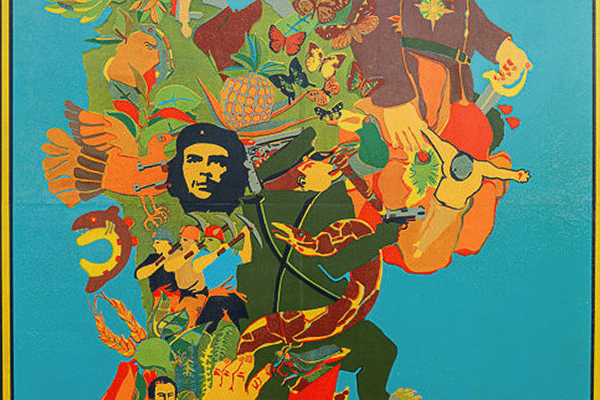The artworks featured in this dossier are among the survivors of the 1973 coup against Chile. Before the coup, they were part of the collection of Museo de la Solidaridad (‘Museum of Solidarity’), a project created by the Popular Unity government to encourage the donation of artworks from across the Americas and Europe. The vision of this project, which was in full force from 1971 until the coup in 1973, was to create a museum of international art for the Chilean people. Following the coup, however, many of those works were destroyed.
Despite the coup regime’s attempts to erase the museum, Chilean cultural workers who were underground and in exile revived the institute abroad between 1975 and 1990 under the name the Salvador Allende International Museum of Resistance. The project was restored in 1991 following the return of democracy in Chile and is now called the Salvador Allende Solidarity Museum (MSSA).
All images included in this dossier (except for the photograph of Augusto Pinochet’s soldiers burning Marxist books and the silkscreen print America Awakens) were loaned by the MSSA.
Foreword
PABLO MONJE-REYES, DIRECTOR OF THE INSTITUTO DE CIENCIAS ALEJANDRO LIPSCHUTZ CENTRO DE PENSAMIENTO E INVESTIGACIÓN SOCIAL Y POLÍTICA
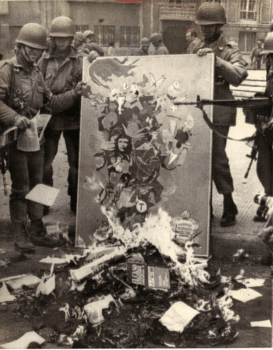
Augusto Pinochet’s soldiers burn Marxist books and the silkscreen print America Awakens, 28 September 1973.
(Photo: Central Intelligence Agency Freedom of Information Act, Weekly Review via Wikimedia Commons.)
The relationship between Chile, the curtailment of its socialist reforms, and the ongoing processes in other countries in the region and in the Global South more generally have been systematically erased in Chile, from official historiography and media narratives alike. The interdependence of the processes involved, the solidarity and support for the Popular Unity project, and the strategies used to generate new forms of internationalism have disappeared even from the stories constructed by some on the left, thereby reaffirming the uniqueness of Chile as an ideal site to consolidate the neoliberal project.
The widely held understanding in Chile and abroad is that the United States’ participation in the financing, organisation, and execution of the 1973 coup took place in response to the copper nationalisation process. However, this perspective does not allow us to appreciate the power of the nationalisation project and its implications with respect to the Popular Unity government’s international economic relations policy and strategic approach. In dossier no. 68, The Coup Against the Third World: Chile, 1973, the Instituto de Ciencias Alejandro Lipschutz Centro de Pensamiento e Investigación Social y Política (ICAL) in Chile and Tricontinental: Institute for Social Research present an analysis of the 1973 coup against Chile and its effects on the Third World and non-aligned countries, which contain lessons that the peoples of the Third World must keep in mind today and always. This dossier also provides key information about why coups take place. In particular, it describes the role of the United States in the plotting of the coup against Chile. This is evidenced by documents that were kept secret at the time, as they reveal an imperialist nation’s interference in the internal affairs of a democratic country that had asserted its autonomy to build a new social project for its people. This dossier develops two axes: first, the political objectives of the nationalisation of copper, and second, the role that it played within the framework of a broader conversation among Third World countries aimed at the creation of a New International Economic Order (NIEO).
Nationalisation was by no means an innovation within the framework of Chile’s economic development. It had been posited as a necessity, and then partially executed, by the government of Eduardo Frei (1964—1970), but it was then senator Salvador Allende who raised the subject of the distinctions between the different ways that production of national assets could be nationalised. On the day that Congress approved the nationalisation of copper—11 July 1971 (National Dignity Day)—President Allende gave a speech that set out why Frei’s ‘Chileanisation’ programme had not gone far enough:
[W]e criticise the copper accords, we criticise Chileanisation, and we criticise the nationalisation that has been agreed upon, and… we have always said, and we are reiterating now, that we are in favour of comprehensive nationalisation, so that huge sums of money do not leave the country, so that Chile does not continue to be a beggar country that asks with an outstretched hand for a few million dollars while massive sums of money leave our borders to strengthen the great international copper empires.We do not want to be a developing country that exports capital; we do not want to continue to sell cheap and buy dear. That is why the Popular Unity programme exists, a fundamentally patriotic programme placed at the service of Chile and the Chilean people. And that is why I am here, as the president of the people, to carry out that programme, come what may.1
Allende identifies, values, and empowers copper workers in their leading role in the ongoing process of transformation:
Apart from the importance of the economic sphere… there is also an important political consideration. With the step that we are going to take, we will break with our dependency, our economic dependency. That means political independence. We will be the owners of our own future, the true sovereigns of our own destiny. What is done with our copper will depend on us, on our capacity, on our effort, and on our sacrificial dedication to ensure that copper in Chile is produced for the progress of our country. The people will have to understand—and they do understand—that this is a great national challenge, and that it is not only the mine workers that have to respond to this, but the Chilean people as a whole.2
Allende also places this process within the framework of the new forms of internationalism present in the Third World project:
The price of copper has also remained high indisputably due to the conflict in Vietnam. But we Chileans, with our conscience, would prefer to see the price of copper decrease, and that the attack against a small and dignified people who are fighting for their independence be ended. We have enough revolutionary consciousness to understand that the price of copper can decrease, and we can accept that, as long as peace can come to Vietnam and the people of Vietnam can have the right to live their own lives. …
We have not been able to develop the capacity of our people, limited by the foreign tutelage imposed on us by development and exploitation planned from afar. We must also understand that this is a challenge to our capacity… Chileans will manage just fine, and luckily we have a language in common with our compatriots in the world market, with Zambia, with the Congo, with Peru, and the Intergovernmental Council of Copper Exporting Countries (CIPEC), which has been formed on an international level and is designed to defend the interests of small-producing countries like ours.3
In relation to Chile and the NIEO, Allende’s statement at the third session of the United Nations Conference on Trade and Development (UNCTAD), held in Santiago de Chile in 1972, is of particular interest. At this conference, President Allende outlined the position of his government and the objectives of its international economic relations policy from a revolutionary perspective that retains its relevance today. In Allende’s words, this position sought ‘to replace an obsolete and radically unjust economic and trade order with an equitable one that is based on a new concept of man and human dignity and to reformulate an international division of labour that is intolerable for the less advanced countries and that obstructs their progress while favouring only the affluent nations’.4 This means that the programmatic, political, and ideological issues cited by Allende remain valid and necessary in all societies suffering from the consequences of imperialism.
The Popular Unity project, headed by Salvador Allende, was without question emancipatory, comprehensive, and Third Worldist and built a socialist society through a democratic and sovereign economic path. To the imperialists, this was simply unacceptable.
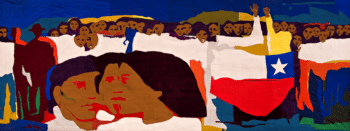
Gracia Barrios (Chile), Multitud III (‘Multitude III’), 1972. Patchwork, 305 x 782 cm.
On 11 September 1973, reactionary sections of the Chilean army, led by General Augusto Pinochet, left the barracks and overthrew the democratically elected government of President Salvador Allende and the Popular Unity coalition. In the melee around the attack on the presidential palace known as La Moneda, Allende died. The military and other security forces began an assault on the organised sectors of society, making mass arrests and setting in place a regime of repression, which included permanent centres of torture and assassination. Large sections of the Chilean left—if they were not murdered—were welcomed in other countries, where they regrouped and began a struggle against the dictatorship. Workers’ movements, now robbed of their leaders, fell prey to the coup’s newly appointed neoliberal administration. Many of the members of this new administration, led by Pinochet (who referred to himself as the ‘Supreme Chief of the Nation’), had been trained in the United States, including several who had worked with Milton Friedman at the University of Chicago and came to be known as the Chicago Boys. The socialist programmes and policies of the Popular Unity government were dismantled. Chile entered a phase of twilight, a laboratory for neoliberalism.
Why did the soldiers leave the barracks on the morning of 11 September? Arguments made by General Pinochet and those around him about law and order have no basis in fact. The truth is that the coup—conceived, prepared, and executed by the U.S., as numerous declassified documents show—did not take place merely on that day in 1973. The U.S. government, acting on behalf of U.S.-based transnational corporations and the dependent Chilean bourgeoisie, had never wanted Allende to win the presidency—which he did, on 4 September 1970—and so they set out to destabilise the Popular Unity government from the day it took office in November 1970.
It was the Allende government’s policies to nationalise copper that spurred the coup. But the policy to nationalise copper—which was approved in Congress in July 1971—was part of a broader conversation in the Third World to create a New International Economic Order (NIEO), which would restructure the neocolonial international economic system along democratic lines and give weight to the ideas and peoples of the Third World. The NIEO was drafted by the United Nations Conference on Trade and Development (UNCTAD), led by the Argentinian economist Raúl Prebisch, and sharpened at the third session of UNCTAD (or UNCTAD III) in Santiago, Chile from April to May 1972. This draft was then discussed at the fourth summit of the Non-Aligned Movement held in Algiers (Algeria) between 5 and 9 September 1973, where India’s Prime Minister Indira Gandhi informed the other leaders that Allende was facing a great challenge in his country. ‘We hope for early normalcy’, he declared.
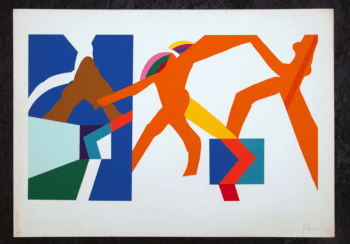
Guillermo Núñez (Chile), Homenaje al trabajo voluntario (‘Homage to Voluntary Work’)’, 1972. Silkscreen print, 53.2 x 75 cm.
On 1 May 1974, the UN General Assembly passed the Declaration of the Establishment of a New International Economic Order, but by then the mood to carry forward its ideas was simply not favourable. The coup against Allende’s government took place not only against its own policy of the nationalisation of copper, but also because Allende had offered leadership and an example to other developing countries that sought to implement the NIEO principles. In that sense, the U.S.-driven coup against Chile was precisely a coup against the Third World.
Sovereignty and Dignity in Chile
On 17 December 1969, the six parties that formed the Popular Unity coalition released their programme. These six parties—the Socialist Party, the Communist Party, the Radical Party, the Social Democratic Party, the Popular Unitary Action Movement, and Independent Popular Action—came together around this programme and used it in Allende’s presidential campaign, which would be held on 4 September 1970. The programme laid out the problem precisely and directly:
Chile is in a state of profound crisis that is manifesting itself in economic and social stagnation, widespread poverty, and the forms of total neglect suffered on all fronts by workers, peasants, and other exploited groups; in the increasing difficulties that face white-collar workers, professionals, and small and medium businessmen; and in the limited opportunities available to women and young people.1
Nothing here would surprise any of the peoples in Africa, Asia, and the other countries of Latin America. At UNCTAD II, in 1968, there was already dismay among the 121 participating governments about the low average annual rate of economic growth of developing countries, which had begun to slump by the mid-1960s.2‘Tremendous problems of poverty, malnutrition, unemployment, and underemployment continue to affect millions of people on the Earth’, UNCTAD wrote in a summary statement of the conference. ‘That was depressing, but it was also a challenge; needs must be matched with action—urgent and concerted action’. Those issuing this call for action—which resonated with tone of the Popular Unity election campaign—were aware, however, of the limitations posed by the neocolonial world system. ‘It should not be forgotten’, participating countries continued, ‘that the existing situation had been caused by certain powers acting in their own interests—power that continued to control a large part of the international economy and to hamper the development of the young nations’.3
The Popular Unity programme sought to explain why the population of Chile—a country rich in natural resources (especially copper)—was struggling to survive:
What has failed in Chile is a system that does not correspond to the needs of our time. Chile is a capitalist country, dependent upon imperialism, dominated by sectors of the bourgeoisie that are structurally tied to foreign capital. These sectors are unable to solve the country’s fundamental problems, problems that are derived precisely from class privileges that they will never give up voluntarily.4
The focus, for Allende’s Popular Unity coalition, was on copper, one of the most important non-ferrous commercial metals of the modern world. Roughly twenty percent of the world’s known copper reserves at the time were in Chile, with substantial copper reserves also held in the United States, the Soviet Union, Zambia, Zaire, and Canada.5 The U.S. was the world’s largest importer of copper, which it then processed for industrial use, and Gran Minería, made up of three U.S. transnational companies (Anaconda, Kennecott, and Cerro), accounted for over eighty percent of Chile’s copper production.6
Gran Minería’s high copper prices and profits in the 1960s raised the pressure for rapid nationalisation. In 1966, Chile’s President Eduardo Frei—responding to the increasing pressure—began a policy to ‘Chileanise’ copper, which meant that U.S. companies would gradually offload ownership (though, despite this new policy, Gran Minería’s profits nonetheless increased dramatically between 1965 and 1971).7 As a result of the increasing popular pressure to use Chile’s natural resources for the benefit of its people, both candidates for the 1970 presidential election—Allende for Popular Unity and Radomiro Tomic for the Christian Democrats—supported nationalisation.8
In December 1970, the Popular Unity government put a constitutional amendment before Congress to nationalise the copper mines owned by Gran Minería, which would not receive any further compensation. The argument made by the Popular Unity government for this refusal to pay compensation—validated by the UN’s Economic Commission of Latin America (CEPAL)—was that Gran Minería had already benefited from decades of excess profits that had been remitted out of the country and had left the mines significantly depleted.9 The Popular Unity government’s refusal to pay additional compensation to Gran Minería marked a sharp departure from the other political parties that the mines would have to be compensated.
On 21 December, Allende spoke at the Plaza de la Constitución and laid out, as he said, ‘a few figures’.10 After showing how Chile had been ‘bled dry’, Allende said flatly, ‘No compensation is to be paid for the [copper] deposits. … We are acting within the legal and juridical channels. In addition, it is relevant to point out that the United Nations has recognised the right of peoples to nationalise the crucial wealth that is held in the hands of foreign capital’ (referring to UN General Assembly resolution, the ‘Permanent Sovereignty Over Natural Resources’).11 On 11 July 1971, commemorated today as National Dignity Day, Chile’s National Congress approved law no. 17450, thereby ratifying the nationalisation of copper.
The Popular Unity government expected to use the increased revenues from copper exports to fund its programme to transform life in Chile. And so it did, instituting healthcare, educational, and agrarian reforms, constructing homes for the working class and peasantry, and implementing a programme that delivered half a litre of free milk per day to children. By 1973, 3.6 million children received milk through this scheme, dramatically reducing malnutrition rates among children, which, before Popular Unity took office, hovered around twenty percent.12
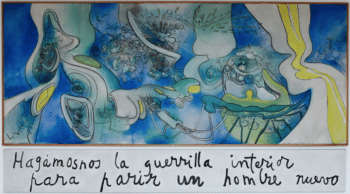
Roberto Matta (Chile), Hagámosnos la guerrilla interior para parir un hombre nuevo (‘Let’s Fight the Guerilla War Within Ourselves to Give Birth to a New Man’), 1970. Oil on canvas, 259 x 491 cm.
On 13 January 1971, at the inauguration of a new trade union school at the University of Chile in Valparaiso, Allende declared that his country was a ‘social laboratory’ and that it was in the midst of ‘an in-depth and profoundly revolutionary process… that has the essential characteristics to be carried out in all aspects of Chilean life’.13 Establishing Chile’s sovereignty over its economy would now open la vía chilena, the Chilean road to socialism. From the afuerinos (landless peasants) to the enfermeras (nurses), Allende’s government promised a new reality, a socialist future.
Chile and the New International Economic Order
In 1971, Chile became the fifty-fifth full member of the Non-Aligned Movement (NAM), roughly a decade after the group formed in 1961. Up until the third NAM summit in Lusaka (Zambia) in 1970, where Chile was one of twelve observer nations, Cuba had been the only Latin American country to be a full member. NAM and UNCTAD incubated debates about the New International Economic Order, a proposal through which the Third World countries sought to transform the neocolonial world system by uniting around the need to control their natural resources and establish their own industrial capacity. Part of this new buoyancy was exerted politically, as African and Asian countries insisted that the third session of UNCTAD be held in a developing country—not in Geneva. Allende put a bid in for Santiago to host the session, which, after some deliberation, was accepted.17 When Allende attended the ground-breaking inauguration of the building where it would be held (on La Alameda in downtown Santiago), he said that this international forum would allow developing nations to ‘make known the dramatic situation of their underdeveloped countries’.15
The new UNCTAD building was less than ten kilometres away from the office of the UN Economic Commission of Latin America (ECLAC), where economists from across Latin America had, since its founding in 1948, developed a theory of dependency. This theory asserted that the world is driven by a neocolonial system in which the core countries (the imperialist powers) dominate the periphery (developing countries) through the reproduction of the gains of the colonial era; through the unequal terms of trade set in place that used the periphery as a resource for raw materials and a market for final products; and through the use of development aid to drive a debt-austerity cycle that entrapped countries in the periphery.16 Pedro Vuskovic, one of the cepalistas, became Allende’s minister of economic affairs, bringing this theory into the Popular Unity’s programme and government policy.17 For a moment, Chile was the centre of the project to break down the neocolonial world system and establish the NIEO. These are some of the main elements that the U.S. government and transnational corporations have tried to ignore as the reasons for the civil-military coup d’état.
At the opening of UNCTAD III in 1972, Allende delivered a monumental speech. The basic mission of the conference, he said, was to replace ‘an obsolete and radically unjust economic and trade order with a fairer one based on a new concept of man and human dignity and to reformulate an international division of labour that the less advanced countries could no longer tolerate, inasmuch as it obstructed their progress while favouring only the affluent nations’.18 The affluent nations would defend their advantages with ‘tireless tenacity’, in Allende’s words, which is why the poorer nations had to be united and clear about their objectives. Those present had no choice because, he continued, ‘if the present state of affairs continues, fifteen percent of the Third World population is condemned to die of starvation’.19 Allende raised five key issues that he argued needed to be addressed in the transformation from the neocolonial, capitalist world order to one committed to advancing humanity:
- Reform monetary and trade systems. The Third World states had minimal representation at the 1944 Bretton Woods Conference in the United States, where the International Monetary Fund and the World Bank were created, and were entirely absent (except for some colonies) when the Western countries created the General Agreement on Trade and Tariffs (GATT) in 1947. As a result, these monetary and trade systems were designed to benefit the affluent nations. The Third World created UNCTAD as the platform to rethink these systems, but, from its founding in 1964, the West tried to marginalise UNCTAD as well as the inputs of post-colonial states on the debate about monetary and trade policy. In 1971, the United States unilaterally abandoned the gold system, enshrining the dollar as the global fiat currency, and by the 1973 Tokyo Round of GATT negotiations, the United States, the European Economic Community, and Japan had begun to reconsider the monetary and trade system without any input from the Third World. Faced with this scenario, Allende said, UNCTAD needed to build a trade system that prioritised increasing popular consumption, eradicating hunger and illiteracy, and regulating the power of transnational corporations.
- Cancel debt burdens. At the World Bank meeting in Nairobi (Kenya) in 1973, roughly a year after Allende’s speech at UNCTAD III, the bank’s president, Robert McNamara, made the point that the ‘essence of the debt problem’ is not the volume of the debt, but rather that ‘debt, and debt payments, are growing faster than the revenues required to service them’.20 Countries in the developing world were trying to attract finance not for the purpose of capital investment, but in order to service their debt.
At UNCTAD III, Allende pointed out that the debt of developing countries had already reached $70 billion. These debts, he said, are ‘largely contracted in order to offset the damage done by an unfair trade system, to defray the costs of the establishment of foreign enterprises in our territory, [and] to cope with the speculative exploitation of our reserves’.21 Key documents, such as the Lima Declaration of the G-77 and the UN General Assembly resolution ‘The Increasing Burden of Debt Services’ (both published in 1971), had already raised this sentiment, urging creditors to reconsider their actions ‘for long-term avoidance of debt crises’, as the UN put it.22 - Consolidate control over natural resources. In May 1969 in Viña del Mar (Chile), the governments of Latin America underscored the need to wrest control over their own natural resources. The text that emerged from this meeting, The Latin American Consensus of Viña del Mar, influenced the Lima Declaration (1971), from which Allende quoted during UNCTAD III, declaring that: ‘The recognition that every country has the sovereign right to freely dispose of its natural resources in the interests of the economic development and well-being of its own people [and that] any external, political, or economic measure or pressure brought to bear on the exercise of this right is a flagrant violation of the principles of self-determination of peoples and of non-intervention, as set forth in the Charter of the United Nations, and, if pursued, could constitute a threat to international peace and security’.23 ‘Chile has nationalised copper’, Allende said, and this nationalisation has been paid for by the excess profits pilfered by the copper conglomerate. The Popular Unity government was not merely asserting ideals, Allende said—it had put these ideas into practice with ‘profound conviction’.24
- Affirm the right of nations to technology and science. The Third World countries, Allende explained , ‘watch the march of science as outsiders’ and import ‘technical know-how which in many cases simply constituted an instrument of cultural alienation and of increased dependence’. Countries such as Chile needed to develop their own scientific and technological capacity, and they needed to collaborate with other countries to create technologies ‘to suit our needs and our development plans’.25
- Build a peace economy. The need of the hour, Allende argued, was to ‘turn a war economy into a peace economy’, to use the waste spent on war and armaments to ‘cement a solidarity economy on a world scale’.26 In 1970, the Stockholm International Peace Research Institute noted that seven percent of the global Gross Domestic Product went towards military expenditures, ‘equivalent to the total income of the poorer half of the world’s population’.27 A cut in arms spending, Allende pointed out, ‘would finance major projects and programmes for [Third World] countries’.28
In April 1972, U.S. National Security Adviser Henry Kissinger’s assistant on Latin American affairs, William Jorden, wrote that Allende was ‘increasingly positioning himself as leader of [the] Third World’.29 The example of la vía chilena, or the Chilean road to socialism, elevated by Chile’s aggressive nationalisation of its metal reserves, provided Allende with the necessary prestige to emerge as a clear voice for the Third World as it pushed the NIEO forward. As a result, Chile’s leadership, with persistent diplomatic work by other Third World states (including Mexico), pushed UNCTAD III to pass the ‘Charter of Economic Rights and Duties of States’, which was eventually adopted by the UN General Assembly as a resolution in December 1974.30
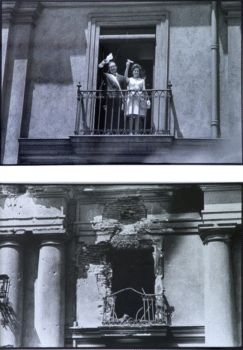
Top: Luis Poirot (Chile), Presidente Salvador Allende y Hortensia Bussi (‘President Salvador Allende and Hortensia Bussi’), 1970. Photograph, 20 x 30 cm.
Bottom: Luis Poirot (Chile), Balcón del Palacio de La Moneda, Septiembre 1973 (‘Balcony of La Moneda Palace, September 1973’). Photograph, 20 x 30 cm.
Though such examples of forward motion at UNCTAD III were minimal, the general sensibility in the Third World was, nonetheless, that change was inevitable.31 The Triad (the United States, Europe, and Japan) went to great lengths to stop the NIEO and, towards that end, formed the G-7 in 1973. At the first G-7 meeting, West Germany’s Helmut Schmidt said that the Western leaders cannot allow decisions about the world economy to be made by ‘officials somewhere in Africa or some Asian capital’. Prime Minister Harold Wilson of the United Kingdom agreed, adding that those decisions must be made by ‘the sort of people sitting around this table’.32
What Coups Do
On 5 August 1970, a month before Allende won the presidential election, the United States government was already thinking about taking ‘action to overthrow Allende’, as U.S. Assistant Secretary of State John Crimmins wrote to U.S. Ambassador Edward Korry.33 Two hundred years ago, in 1823, the United States put forth the Monroe Doctrine, which plainly stated that Europe must not interfere in the Americas since the hemisphere was the ‘backyard’ of the United States.34 Interventions in Latin America—from the seizure of just over half of Mexico’s territories in 1848 and the annexation of Cuba and Puerto Rico in 1898 to the overthrow of a string of governments across the hemisphere—became commonplace. In 1964, the United States government openly assisted the Brazilian military to remove the democratically elected government of João Goulart, establishing a military dictatorship that lasted for twenty-one years and abetted the U.S. in installing military dictatorships across South America (Bolivia, 1971; Uruguay, 1973; Chile, 1973; Peru, 1975; Argentina, 1976) through what became known as Operation Condor.
Despite spending millions of dollars on the Christian Democrats in the 1960s, the United States government could not prevent Allende’s victory. Thirteen days after the elections, the U.S. government set up Project FUBELT to attempt to prevent Allende from taking power and—if he did get sworn in—to destabilise Chile and remove him from office. As the CIA’s Chile Task Force wrote in Situation Report #2, ‘there is a coup possibility now in the wind’.35
The United States government tried every means possible to overthrow Allende. This included a military plot that resulted in the assassination of Chile’s highest military officer, General Rene Schneider, as well as a pressure campaign to get Allende’s predecessor, former President Frei, to annul the election and seize power. U.S. Ambassador Edward Korry assembled business leaders in the embassy and told them that ‘not a nut or bolt will be allowed to reach Chile under Allende’.36 Korry, and his successor Nathaniel Davis, worked closely with members of the Monday Club, a group of Chilean business leaders, owners of newspapers (particularly El Mercurio), and right-wing politicians that met every Monday at the office of Hernan Cubillos, who would become the foreign minister under Pinochet from 1978 to 1980, on Lord Cochrane Street in Santiago. Korry, who guided the club, wasted no time in putting into place U.S. President Richard Nixon’s 15 September 1970 instruction to ‘make the economy scream’.37
The U.S. government prevented Chile from accessing dollars through commercial channels and shut down aid, squeezed shipping companies to charge higher freight charges, and encouraged expropriated transnational firms to seize Chilean assets overseas. It did not help Allende’s government that copper prices collapsed in 1971.
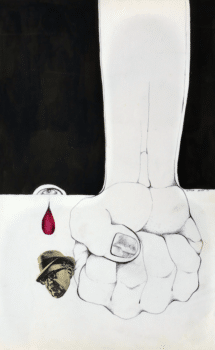
Ximena Armas (Chile), Golpe (‘Coup’), 1973. Collage on paper, 60 x 40 cm.
Allende’s government struggled against this economic strangulation but still managed to hold on. In fact, as an indicator of its political resilience, the Popular Unity slate won 43.39 percent of the vote in the parliamentary elections of March 1973—more than Allende won in 1970 and far more than expected by either the party itself or by the U.S. government. As U.S. Ambassador Nathaniel Davis told Washington, the Popular Unity government’s policies had made the population ‘materially better off’ and ‘doubtless prepared to pay some economic price’ for an ‘enhanced sense of dignity and satisfaction of putting down the upper classes’.38 A month later, Frei and other pro-capitalist political forces, as the CIA described them, ‘reached the conclusion that throughout the so-called Third World the traditionalist capitalist system is not capable of realising development goals and aspirations. Frei had also been impressed over the relative success and rapidity in which Allende… has dismantled previously existing bastions of economic power… Frei recognises that he cannot reverse much of what the UP [Popular Unity] has done’.39 In other words, Chile’s classical right-wing parties had conceded defeat, and so other—harsher—forces would have to be summoned to crush la vía chilena and the Third World Project. Those forces gathered around Pinochet, who sent his tanks out of the barracks on 11 September to overthrow the Popular Unity government. Two years later, the role of the United States in fomenting the coup became available for all to see due to the revelations of the U.S. Congress’ Church Committee report (though the report’s implications have not been fully digested around the world).40
Before the coup, far-right groups painted the ominous slogan ‘Jakarta is coming’ on walls across Santiago, conjuring the memory of the murder of over a million communists, trade unionists, peasant organisers, artists, and left sympathisers in Indonesia at the hands of General Suharto’s coup regime, installed in 1965 to displace the left-wing government of President Sukarno.41The words on Santiago’s walls foreshadowed the violence that would be repeated in Chile when Pinochet’s coup regime murdered thousands of people, imprisoned tens of thousands more, and exiled hundreds of thousands, working intimately with the CIA to clinically wipe out the left from the country and send a lesson to any Third World Project that tried to establish its sovereignty and self-determination.42 The violence of the coup regime shaped Chile’s state institutions and the impunity of the security police, the Carabineros, in the decades to come. The brutal murder of world-renowned artists such as Pablo Neruda and Víctor Jara illustrated the coup regime’s deep hatred of the left and lack of concern for the international condemnation of the regime’s violence. Pinochet’s 1980 Constitution—which remains in place despite the return to democracy in 1990 and subsequent efforts to change it—continues to give the executive branch emergency powers to suspend civil rights (which it used to lethal effect against the protests of 2011—2013 and 2019).
In 1969, a group of economists in Chile completed the report El ladrillo (‘The Brick’).43 The prologue was written by Sergio de Castro, trained at the University of Chicago, who would become Pinochet’s minister of the economy. De Castro, along with Carlos Massad (who was the governor of the central bank from 1967 to 1970 and from 1996 to 2003), went to Chicago as part of a programme established with the Ford Foundation and the Rockefeller Foundation.44 De Castro, Massad, and the rest of the Chicago Boys drove an agenda of ‘shock therapy’ that included severely cutting government spending, liberalising imports, and using state entities to provide advantages to large business conglomerates. These conglomerates included transnational corporations and business houses owned by Pinochet’s cronies such as the Banco Hipotecario y de Fomento de Chile and the Cruzat-Larraín empire, known collectively as the ‘Pirañas’. By 1978, Cruzat-Larraín controlled 37 of Chile’s 250 major corporations while Vial controlled 25 of them.45 José Piñera, one of the Chicago Boys and the elder brother of Sebastián Piñera (who was the president from 2010 to 2014 and from 2018 to 2022), set out to destroy labour laws and demobilise trade unions through his post as the head of the ministry of labour. The Chicago Boys used Chile as a laboratory for their neoliberal religion, inviting the two priests of neoliberalism to Chile to meet with Pinochet: Milton Friedman in 1975, along with the Brazilian coup regime’s economist Carlos Langoni, and Friedrich Hayek in 1977.46 Pinochet’s policies produced a boom for the wealthy alongside great suffering for the vast majority of the population.
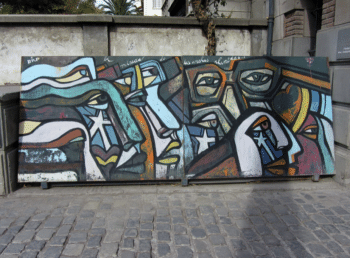
Alejandro “Mono” González (Ramona Parra Brigade, Chile), La mirada de las anchas alamedas (‘The Gaze of Wide Boulevards’), 2005. Mural, 150 x 384.5 cm.
Despite the immense repression of the coup regime, the lineages that produced the Popular Unity government reconstituted themselves and began a process of resistance that—eventually—defeated the coup. The Communist Party (whose leadership had been killed off four times), the Frente Patriótico Manuel Rodríguez, the Movimiento de Izquierda Revolucionaria (MIR), and other left groupings bravely gathered their ranks and began a process of organisation and sabotage, as well as relief for a desperate and terrorised population. A battered trade union movement, which had long been the backbone of Chile’s left, found its buoyancy with new leaders such as Oscar Piño at Santiago’s Goodyear factory. These advances are precisely why some of these leaders were then assassinated, among them Tucapel Jiménez, the founder of the Group of Ten labour federation, which represented 500,000 workers when he was killed in 1982. Civil society was able to be rebuild strong social ties and solidarity through popular organisations that quickly formed in the wake of the coup including community kitchens (ollas comunes), unemployed workers’ centres (bolsas de cesantes), children’s canteens (comedores infantiles), and pioneering social movements, particularly in the arena of labour and human rights, that were led by groups of relatives of the victims of repression. Soon, the women’s and shack dwellers’ movements also began to take shape. Relief and resistance went hand in hand, a brave people holding fast against the coup regime imposed upon them. A decade into the coup, the people returned to the streets with their political parties’ flags in hand to protest against the 1980 Constitution and contest the dictatorship more broadly. It is fitting that the first National Day of Protest on 11 May 1983 was inspired by the copper miners’ strike that year and led by the resurgent trade union movement.
Countless acts of solidarity with Chilean workers spread across the world, with various unions and organisations participating in a solidarity movement that was comparable only to the movement for peace and against the U.S. war on Vietnam. The governments and political movements of the non-aligned countries maintained an attitude of sympathy and collaboration with the democrats in Chile and the world. This international solidarity movement, including in the Third World, never let Pinochet find respectability.
If the slogan for the imperialist bloc in anticipation of the coup was ‘Jakarta is coming’, the slogan for any project that wants to establish the sovereignty of the Third World and the dignity of the peoples is ‘Chile is coming’.
Foreword:
- ↩ Salvador Allende, ‘Discurso con motivo de la nacionalización del cobre’ [Speech on the Occasion of the Nationalisation of Copper], transcript of the speech at the Plaza de Los Héroes in Rancagua, 11 July 1971, https://www.marxists.org/espanol/allende/1971/julio11.htm, our translation.
- ↩ Allende, ‘Discurso’, our translation.
- ↩ Allende, ‘Discurso’, our translation.
- ↩ Salvador Allende, ‘El desarrollo del tercer mundo y las relaciones internacionales’ [Third World Development and International Relations], transcript of the opening speech at the Third World Conference on Trade and Development in Santiago de Chile, 13 April 1972, https://www.archivochile.com/S_Allende_UP/doc_de_sallende/SAde0027.pdf,1—2; United Nations, Proceedings of the United Nations Conference on Trade and Development. Second Session, vol. 1 (New York: United Nations, 1968), https://unctad.org/system/files/official-document/td180vol1_en.pdf, 16.
Notes:
- ↩ Popular Unity, Programa básico de gobierno de la Unidad Popular. Candidatura presidencial de Salvador Allende [Popular Unity’s Basic Government Programme: Presidential Candidacy of Salvador Allende] (Santiago: Instituto Geográfico Militar, 1970), 3, our translation.
- ↩ United Nations, Proceedings. Second Session, 7.
- ↩ United Nations, Proceedings. Second Session, 77—78.
- ↩ Popular Unity, Programa básico, 4, our translation.
- ↩ C. J. Tesar and Sheila C. Tesar, ‘Recent Chilean Copper Policy’, Geography 58, no. 1 (January 1973): 9.
- ↩ In 1970, sixty percent of the world’s copper output was owned by six transnational corporations: three U.S. firms (Anaconda, Kennecott, and Cerro), two British firms (British Insulated Callender’s Cables and IMI Refiners), and one Belgian firm (Metallurgie Hoboken-Overpelt). See Tesar and Tesar, ‘Recent Chilean Copper Policy’, 9.
- ↩ Dale Johnson, ed., The Chilean Road to Socialism (Garden City: Anchor Press, 1973), 28.
- ↩ Andrés Zauschquevich and Alexander Sutulov, El cobre chileno [Chilean Copper] (Santiago: Corporación del Cobre, 1975), 42—48; Norman Girvan, Copper in Chile (Mona: University of the West Indies, Institute of Social and Economic Research, 1972).
- ↩ Comisión Económica para América Latina (CEPAL), Estudio económico de América Latina 1971 [Economic Survey of Latin America 1971] (New York: United Nations, 1972), 118.
- ↩ Salvador Allende, ‘Nacionalización del cobre’ [Nationalisation of Copper], in La vía chilena hacia el socialismo [Chile’s Road to Socialism] (Santiago: Editorial Fundamentos, 1971), 71, our translation.
- ↩ Allende, ‘Nacionalización del cobre’, 74 and 76—77, our translation.
- ↩ Mario Amorós Quiles, Compañero Presidente: Salvador Allende, una vida por la democracia y el socialismo [Comrade President: Salvador Allende, a Life for Democracy and Socialism] (València: València University, 2008), 160—161; Fernando Mönckeberg Barros, ‘Prevención de la desnutrición en Chile. Experiencia vivida por un actor y espectador’ [Prevention of Malnutrition in Chile: The Experience of an Actor and Spectator], Revista Chilena de Nutrición 30, no. 1 (2003).
- ↩ Allende, ‘Participación y movilización’ [Participation and Mobilisation], in La vía chilena hacia el socialismo, 99—100, our translation.
- ↩ Tanya Harmer, Allende’s Chile and the Inter-American Cold War (Chapel Hill: University of North Carolina Press, 2011), 82—83.
- ↩ ‘Series S-0858: Commissions, Committees, and Conferences’, files of the Secretary-General U. Thant, UN Conference on Trade and Development (Miscellaneous), 1961—1971, UN Archives, 23. The building for the conference was constructed in record time with the assistance of both workers and volunteers. After the coup, La Moneda was used as the headquarters of the military junta. Part of the building is now the Centro Cultural Gabriela Mistral.
- ↩ Tricontinental: Institute for Social Research, Dependency and Super-exploitation: The Relationship Between Foreign Capital and Social Struggles in Latin America, dossier no. 67, August 2023; Margarita Fajardo, The World That Latin America Created: The United Nations Economic Commission for Latin America in the Development Era (Cambridge: Harvard University Press, 2022).
- ↩ Pedro Vuskovic, ‘Algunas experiencias del desarrollo latinoamericano’ [Some Experiences of Latin American Development], in Dos polémicas sobre el desarrollo de América Latina [Two Polemics on Latin American Development] (Santiago: Editorial Universitaria, 1970) and ‘La política de transformación y el corto plazo’ [Transformation Policy and the Short Term], in El pensamiento económico del gobierno de Allende [The Economic Thinking of the Allende Government], ed. Gonzalo Martner (Santiago: Editorial Universitaria, 1972).
- ↩ Salvador Allende, Discurso del doctor Salvador Allende G. Presidente de Chile, inaugurando la Tercera Conferencia Mundial de Comercio y Desarrollo [Speech of Dr Salvador G. Allende, President of Chile, Inauguration of the Third International Conference on Trade and Development] (Santiago: UNCTAD, 1972), 8, our translation.
- ↩ Salvador Allende, Discurso, 9, our translation.
- ↩ Robert S. McNamara, Address to the Board of Governors, (Nairobi: World Bank Group, 1973), 8.
- ↩ United Nations, Proceedings of the United Nations Conference on Trade and Development. Third Session, vol. 1 (New York: United Nations, 1973), 354.
- ↩ United Nations General Assembly, ‘The Increasing Burden of Debt Services’, A/RES/2807 (14 December 1971).
- ↩ United Nations, Proceedings. Third Session, 355.
- ↩ United Nations, Proceedings. Third Session, 351—355; Allende, Discurso, 23, our translation.
- ↩ Salvador Allende, ‘El desarrollo del Tercer Mundo y las relaciones internacionales’ [The Development of the Third World and International Relations], inaugural speech at the Third World Conference on Trade and Development (Santiago, 13 April 1972), our translation.
- ↩ United Nations, Proceedings. Third Session, 357; Allende, Discurso, 28; Allende, ‘El desarrollo’, our translation.
- ↩ Stockholm International Peace Research Institute, SIPRI Yearbook of World Armaments and Disarmament 1969/70 (Stockholm: Almqvist & Wiksell, 1970), 3.
- ↩ United Nations, Proceedings. Third Session, 357.
- ↩ Harmer, Allende’s Chile, 161.
- ↩ In 1970, the UN Commission on Human Rights appointed the Iranian diplomat Manouchehr Ganji as a Special Rapporteur. Ganji’s report The Widening Gap: A Study of the Realisation of Economic, Social, and Cultural Rights (1973) emphasised the economic and political weaknesses of the Third World and suggested that the fight for human rights had to be related to the fight for a new international economic order.
- ↩ For instance, Algeria’s Foreign Minister Abdelaziz Bouteflika said in 1972 that ‘the road to Third World economic emancipation… does not run through UNCTAD’. Nonetheless, he played a prominent role at the fourth summit of the NAM in Algeria, where the basis for the NIEO resolution in the UN General Assembly was laid. See Harmer, Allende’s Chile, 163.
- ↩ Vijay Prashad, The Poorer Nations: A Possible History of the Global South (Various publishers, 2013), 53—54.
- ↩ Peter Kornbluh, The Pinochet File. A Declassified Dossier on Atrocity and Accountability (New York: The New Press, 2013), 7.
- ↩ Between 1810 and 1814, the U.S. government sent Joel Roberts Poinsett to Argentina and Chile to assist in the war against the Spanish Empire and to insert U.S. interests at the forefront.
- ↩ Kornbluh, The Pinochet File, 2.
- ↩ Kornbluh, The Pinochet File, 17.
- ↩ Kornbluh, The Pinochet File, 36.
- ↩ Harmer, Allende’s Chile, 205.
- ↩ Harmer, Allende’s Chile, 205—206.
- ↩ U.S. Senate, Senate Select Committee to Study Governmental Operations with Respect to Intelligence Activities (Washington, 1976). Much of the material—and other information released from the CIA and from the Nixon papers—has been compiled in The Pinochet File. For a broader look at Washington’s interference and interventions, see Vijay Prashad, Washington Bullets: A History of the CIA, Coups, and Assassinations (2021).
- ↩ Vincent Bevins, The Jakarta Method: Washington’s Anticommunist Crusade and the Mass Murder Program that Shaped Our World (New York: Public Affairs, 2020).
- ↩ Though these numbers remain in dispute, the official figures can be found in Informe de la Comisión Nacional de Verdad y Reconciliación [Report of the Chilean National Commission on Truth and Reconciliation] (Santiago: Comisión Nacional de Verdad y Reconciliación, 1991), also known as the Retting Commission, and Informe de la Comisión Nacional sobre Prisión Política y Tortura [Report of the National Commission on Political Imprisonment and Torture] (Santiago: Comisión Nacional sobre Prisión Política y Tortura, 2004), also known as the Valech Commission; The Pinochet File, 220—225.
- ↩ The book was published in 1992 by the Centro de Estudios Públicos, set up in 1980 to coordinate the work of the Chicago Boys.
- ↩ Sebastian Edwards, The Chile Project: The Story of the Chicago Boys and the Downfall of Neoliberalism (Princeton: Princeton University Press, 2023); Javier Campos Gavilán, Antecedentes del neoliberalismo en Chile (1955—1975): El autoritarismo como camino a la libertad económica [Background to Neoliberalism in Chile (1955—1975): Authoritarianism as the Road to Economic Freedom] (Santiago: Universidad de Chile, Facultad de Derecho, 2013).
- ↩ María Olivia Monckeberg, ‘El mapa del imperio Cruzat-Larraín’ [The Map of the Cruzat-Larraín Empire], Hoy, no. 145 (30 April 1980): 25—29.
- ↩ Friedman’s trip is well-known, though Hayek’s is not. For further reading on that trip, see Bruce Caldwell and Leonidas Montes, ‘Friedrich Hayek and his Visits to Chile’, Review of Austrian Economics 28, no. 3 (2015).

